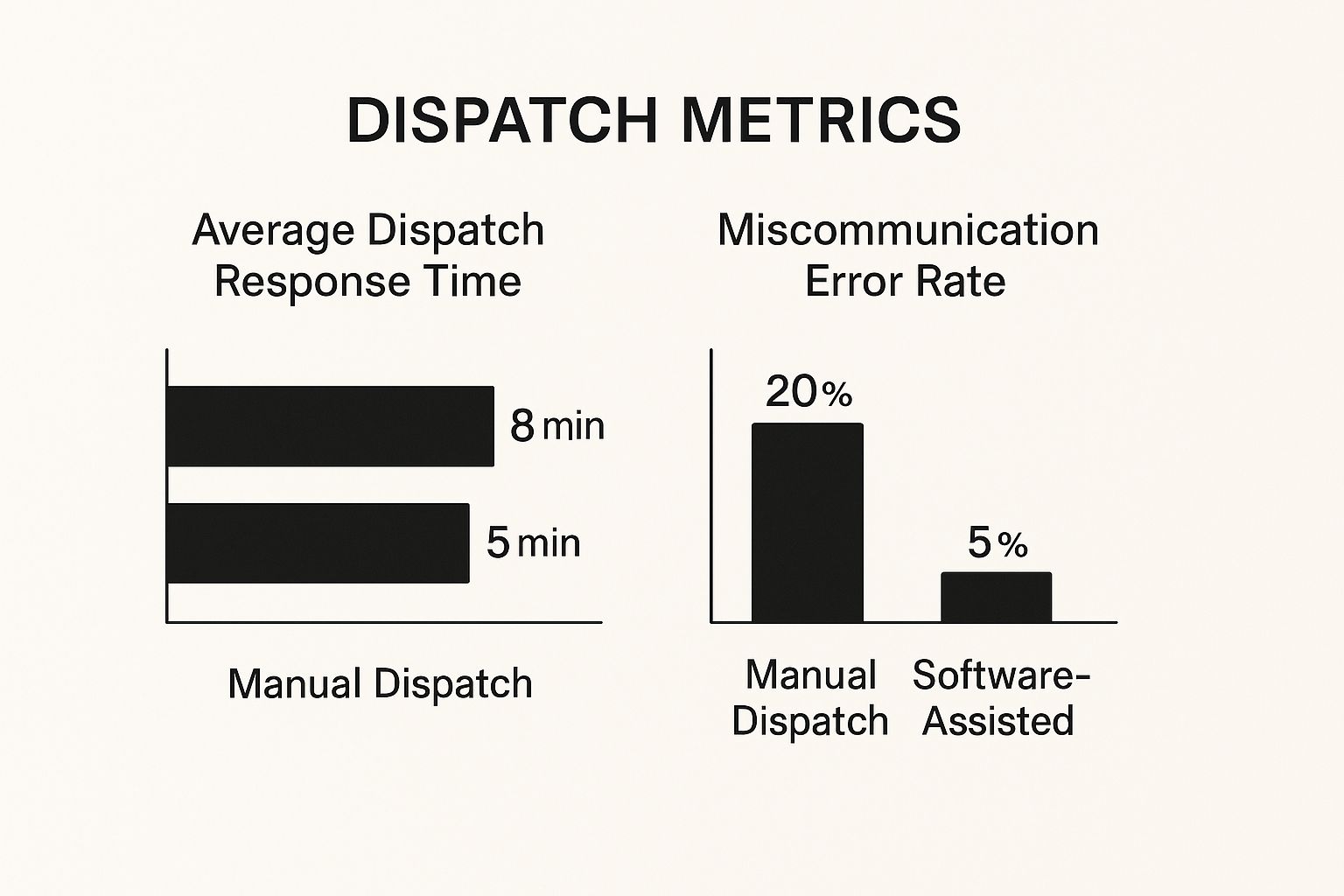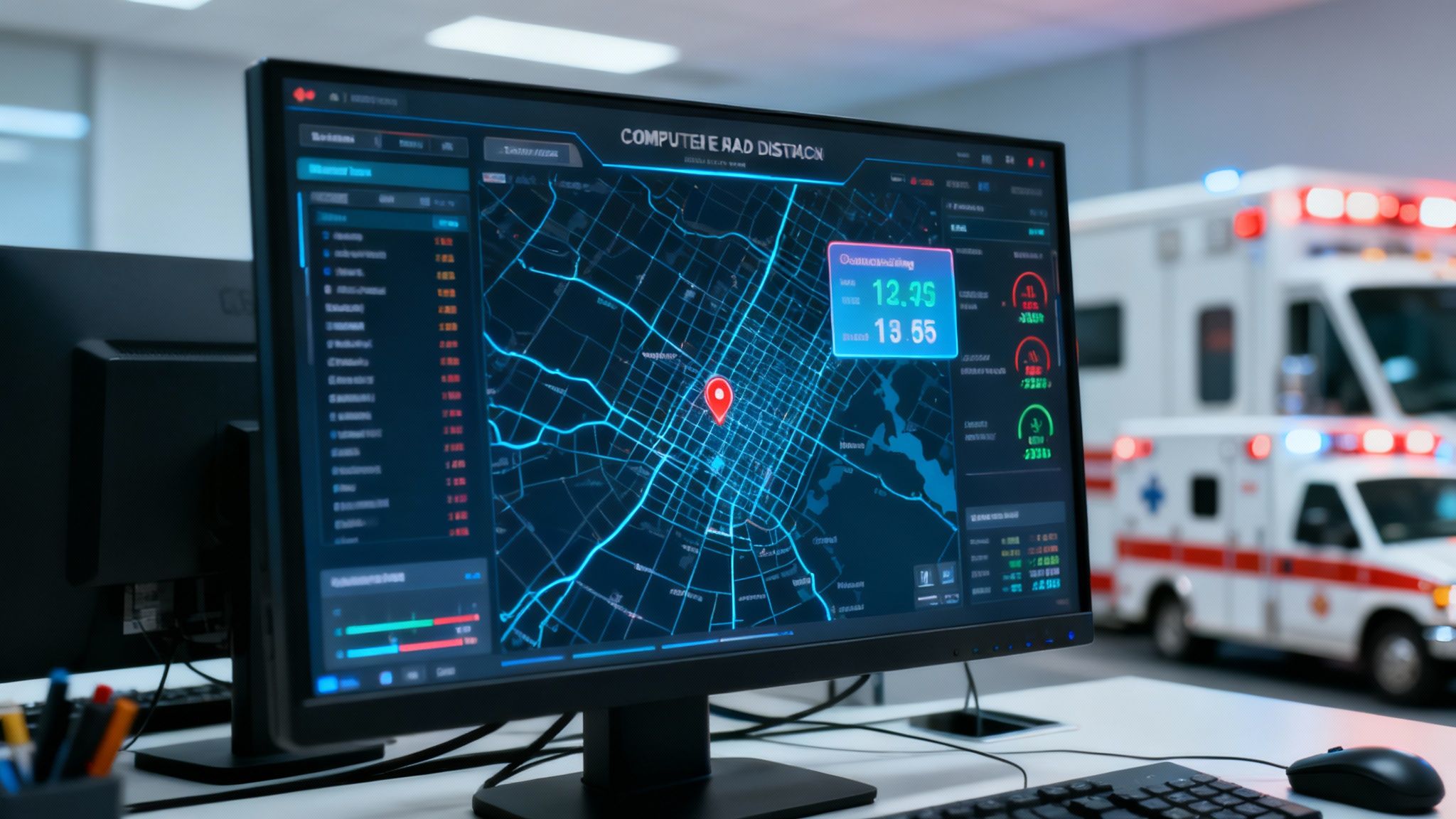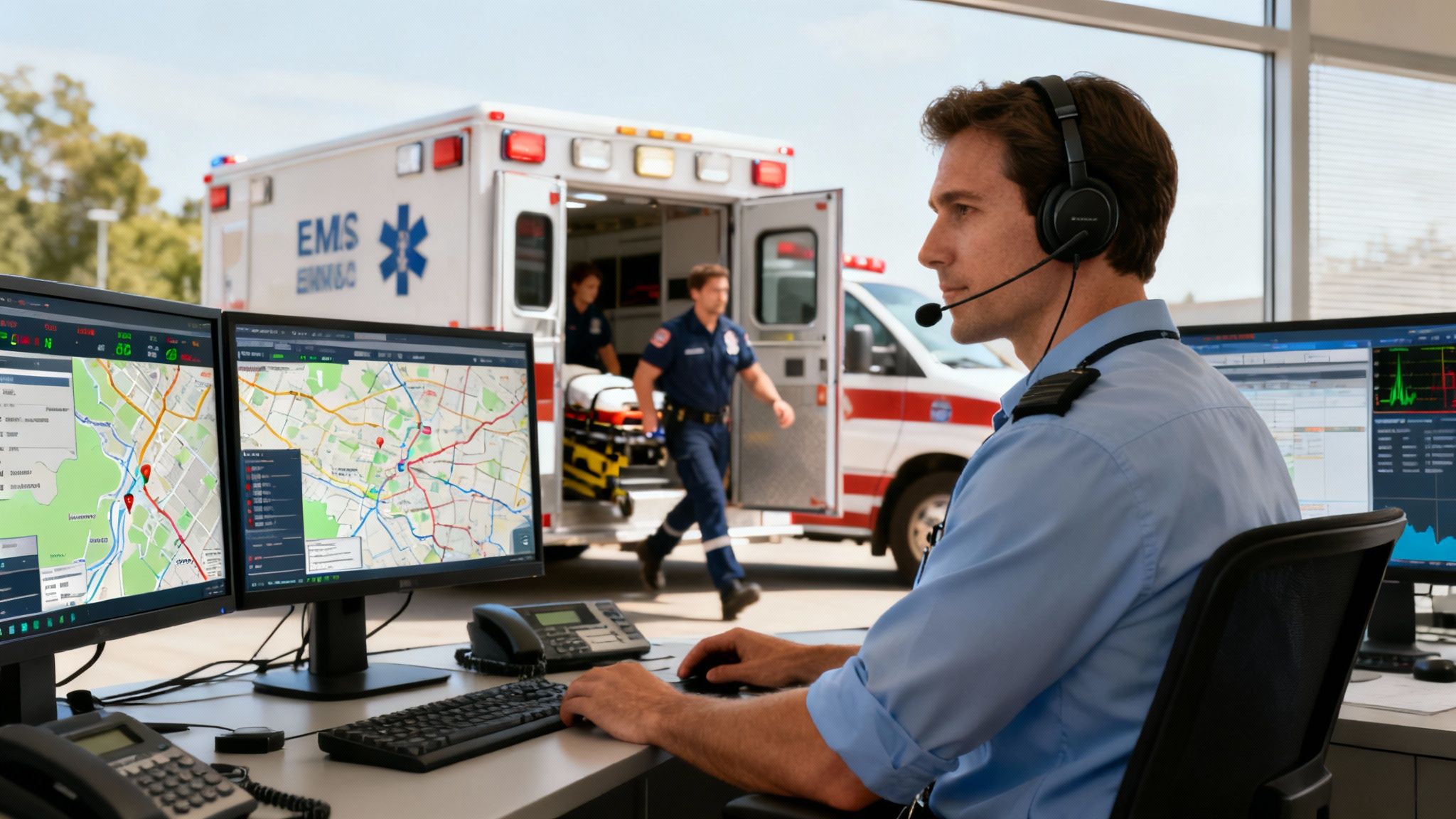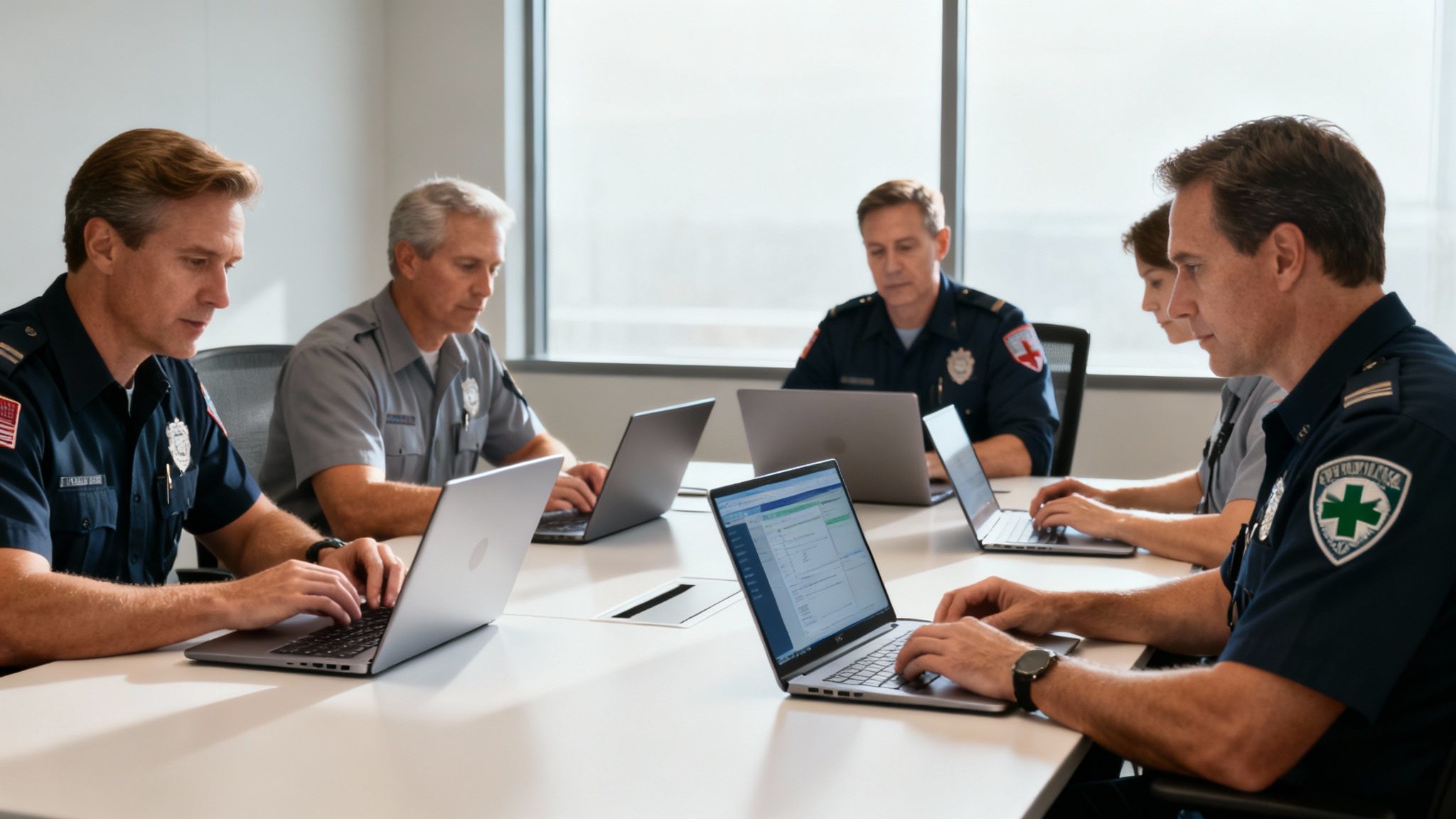EMS Dispatching Software Buyer’s Guide
When a 911 call comes in, chaos can take over in a heartbeat. EMS dispatching software is what turns that chaos into a coordinated, life-saving response. Think of it as the air traffic control for first responders on the ground—an intelligent system that takes an emergency, finds the best resources, and gets them to the scene with speed and precision.
So, What Is EMS Dispatching Software, Really?
Years ago, dispatch was a world of manual guesswork and crackling radio communications. Today's agencies have moved on, using specialized software to cut through the noise and delays that happen in high-stress situations. It creates a single source of truth, so every dispatcher, paramedic, and EMT sees the same real-time information.
This isn't just about sending the closest ambulance. It's about sending the right one with the right crew and gear. For instance, if a call requires advanced life support (ALS), the software instantly identifies and dispatches the nearest ALS-certified unit. It might even bypass a closer vehicle if that team only provides basic life support (BLS). A decision like that, made in seconds, has a direct impact on patient outcomes.
The Key Components Driving Efficiency
At the heart of any solid EMS dispatching system are two core technologies: Computer-Aided Dispatch (CAD) and real-time GPS tracking.
- Computer-Aided Dispatch (CAD): This is the brain of the operation. It logs all the incoming calls, suggests the best units based on their location and status, and tracks every incident from the initial call to the moment the crew clears the scene.
- Real-Time GPS Tracking: Often called Automatic Vehicle Location (AVL), this gives dispatchers a live map showing where every single asset is. They can see every ambulance in motion, which allows them to make faster, more accurate deployment decisions on the fly.
It's this fusion of live location data and automated logic that shifts dispatch from a purely reactive process to a proactive, strategic one. It gets rid of the ambiguity of asking "Who's closest?" by giving a definitive, data-driven answer every single time.
This next infographic really hammers home the difference this tech makes in cutting down response times and preventing miscommunication.

The numbers speak for themselves. Agencies that adopt software-assisted dispatch see a major drop in response times and critical errors, proving just how much it boosts operational effectiveness when it matters most.
Core Features That Cut Costs and Boost Performance
Modern EMS dispatching software isn't just a fancy digital map. Far from it. Think of it as the operational engine for your entire agency, one specifically designed to drive efficiency and deliver some very real cost savings. By taking over critical tasks and serving up real-time data, these platforms turn messy, complex challenges into manageable, cost-effective solutions. Every feature is built to boost performance, and nearly every one has a direct impact on your bottom line.

The heart of the whole operation is the Computer-Aided Dispatch (CAD) system. It's the software's brain. Bringing CAD systems into the EMS world has completely changed the game for emergency response. It automatically picks the best unit for a call based on location, crew certifications, and current status, getting rid of the manual guesswork that burns through precious time.
Automated Unit Selection and GPS Tracking
One of the biggest money-savers is Automatic Vehicle Location (AVL), which uses GPS to give you a live, bird's-eye view of your entire fleet. This isn't just for watching dots on a map; it's a powerful tool for controlling costs.
Instead of sending a unit that just seems closest, the software crunches the numbers and identifies the absolute nearest available ambulance. This might sound like a small tweak, but the financial impact over thousands of calls is massive.
- Here’s a practical example: An agency with 10 ambulances might find that smart, optimized routing shaves an average of three miles off every call. Over a year, that can easily save over $10,000 in fuel alone—not even counting the reduced wear and tear on the vehicles.
- Actionable Insight: Use the software's reporting tools to run a monthly "Miles per Call" report. If you see the average mileage creeping up, it could signal an issue with how units are being staged or if crews are taking inefficient routes. This data gives you a chance to correct the problem before it wastes thousands of dollars.
This kind of precision routing can lead directly to a 5-10% drop in an agency's annual fuel budget. It’s one of the clearest ways a software investment starts paying for itself almost immediately.
Integrated Communications and Data Management
A solid EMS dispatch platform also pulls all your communication channels into one place. This means you can ditch the jumble of multiple, often expensive, third-party messaging apps and radios. Dispatchers, crews, and supervisors can all talk securely within one system.
For this all to work smoothly, the software leans heavily on good healthcare interoperability. That's just a way of saying it ensures data flows seamlessly between dispatch, the crews in the field, and the receiving hospitals.
By connecting the data from the initial 911 call all the way to the final patient report, agencies can speed up their billing cycles. When electronic Patient Care Reports (ePCRs) are linked directly to dispatch records, billing information gets captured accurately and submitted way faster, which does wonders for your cash flow.
The table below breaks down exactly how these software features translate into tangible savings.
How EMS Software Features Translate to Real Savings
| Feature | Operational Benefit | Direct Cost-Saving Example |
|---|---|---|
| GPS-Based Unit Selection | Reduces mileage and vehicle wear. | Lowers annual fuel consumption by 5-10%; decreases maintenance costs. |
| Integrated Communications | Eliminates need for multiple third-party apps. | Saves money on separate messaging and PTT service subscriptions. |
| Automated Reporting | Reduces administrative workload. | Cuts down on staff hours spent on manual report generation and data entry. |
| ePCR Integration | Speeds up the billing and reimbursement cycle. | Improves cash flow by submitting accurate claims faster, reducing delays. |
Ultimately, a system that lets you manage personnel, track equipment, and pull detailed reports gives administrators the hard data they need to make smarter financial decisions. To see how all these pieces fit together, it’s worth exploring the full range of features available in a modern dispatch platform. A comprehensive system doesn't just improve today's operations; it provides the long-term insights you need to run a more efficient and financially healthy organization for years to come.
How This Actually Affects Response Times and Patient Care
Let's move past the feature lists and technical specs for a moment. The real test of any EMS dispatching software is its impact in the field—how it saves lives and keeps an agency running smoothly. This technology is the critical link between a frantic 911 call and the moment skilled medics arrive on scene. It's what turns a chaotic situation into a controlled, efficient response.
Every single second shaved off a response time can change a patient's outcome for the better. That's not an exaggeration; it's the reality of emergency medicine.

Think about a cardiac arrest call. The old way involved a dispatcher manually checking a list of units, radioing the crew they thought was closest, and then waiting for confirmation. It was the standard for decades, but every step introduced small, yet potentially fatal, delays.
Modern dispatch software completely changes the game. As soon as the call details are punched in, an algorithm instantly pinpoints the closest, most appropriate unit—maybe an Advanced Life Support (ALS) team—and gets them rolling with a single click. For a cardiac arrest, where survival rates plummet by 7-10% for every minute without CPR and defibrillation, those seconds saved by software aren't just a nice-to-have. They are life-altering.
From Raw Data to Smarter Decisions
The benefits don't stop once the ambulance leaves the bay. The data and reporting tools baked into this software give administrators a level of oversight they've never had before. It's the difference between relying on gut feelings and making decisions backed by hard evidence. You can finally spot the operational bottlenecks that were always there, but completely invisible.
This ability to dig into performance metrics is a huge advantage for saving money and making a case for resources. Here's a real-world example:
- Spotting Slow Zones: Analytics might show a particular neighborhood consistently has response times dragging behind the average, especially in the evenings.
- Actionable Insight: Instead of just guessing why, administrators see the data plain as day. This gives them the justification to stage an ambulance at a strategic standby location in that zone from 5 PM to 9 PM.
- Cost-Saving Result: It's a simple, data-driven tweak that improves coverage and slashes response times without the massive cost of adding a whole new crew and truck. For example, proactively moving one unit for four hours costs far less in fuel and wages than having to build and staff an entire new station to solve the coverage gap.
By turning operational data into a strategic asset, EMS dispatching software gives agencies the power to use their resources intelligently. This means delivering better, faster care to the community while making sure every dollar in the budget is spent as effectively as possible.
Justifying Growth and Improving Care
This data-driven approach is also a game-changer for long-term planning. When an agency needs to go to the city council and ask for funding for more staff or a new station, they're no longer just saying, "We feel busier." They can present detailed reports showing increased call volume, unit utilization rates, and response time trends. That's the kind of concrete evidence that builds a compelling case.
Of course, a rapid response is only one part of the equation. Great patient care also depends on accurate and thorough record-keeping. This is where technologies like advanced medical documentation software come in, making sure the vital information captured in the field seamlessly follows the patient through their entire journey of care.
The growing dependence on these systems isn't just a fluke; it's a clear industry trend. The global market for this kind of technology is expanding fast, which tells you that agencies all over the world are recognizing its immense value. In fact, projections show the Emergency Medical Service (EMS) software market is expected to grow from USD 1.25 billion in 2023 to USD 2.61 billion by 2032. That growth is fueled by one simple fact: the intense, undeniable need for more efficient emergency response.
How to Choose the Right EMS Dispatching Software
Picking the right EMS dispatching software is one of the most critical decisions an agency leader can make. This isn't just about buying a new piece of tech; you're investing in the very backbone of your operation. This choice will echo through your response times, your crew's morale, and your budget for years to come. Getting it right demands a smart, strategic approach that starts way before you ever see a product demo.
Here's the single best money-saving tip I can give you: conduct a thorough needs analysis before you start window shopping. I've seen too many agencies jump straight into vendor calls without a clear map of their own challenges. It’s a surefire way to get upsold on flashy features that sound amazing but don't solve your actual problems, adding thousands to your annual bill for tools you’ll never touch.
- Practical Example: Before talking to vendors, sit down with your dispatchers and medics. Ask them: "What are the three biggest time-wasters in our current dispatch process?" Their answers—like manually logging unit status or struggling with a clunky interface—become your non-negotiable "must-have" features, preventing you from overspending on unnecessary extras.

Key Evaluation Criteria
Once you’ve got a handle on what you truly need, you can start sizing up potential solutions. I recommend focusing on three areas that really determine a system's long-term worth: scalability, interoperability, and usability.
- Scalability: Can this system grow with you? A platform that works perfectly for 10 units today might completely crumble under the weight of 20. You have to ask vendors how their system handles a surge in call volume, more users, and an expanding fleet.
- Interoperability: Does it play nice with your other tools? Your dispatch software is just one piece of the puzzle. It absolutely must integrate with your existing billing and electronic Patient Care Report (ePCR) systems. If it doesn't, you're creating data silos and sentencing your team to endless manual data entry—a huge time-waster and a breeding ground for errors.
- User-Friendliness: Is it intuitive for a dispatcher under immense pressure? When seconds count, a clunky or confusing interface is a liability. It can slow down critical thinking. The best systems are built for speed and clarity, helping dispatchers stay locked in during a major incident.
On-Premise vs Cloud-Based Solutions
Another fork in the road is deciding between an on-premise system you host yourself versus a cloud-based Software as a Service (SaaS) model. Each path has a totally different impact on your total cost of ownership.
| Factor | On-Premise Solution | Cloud-Based (SaaS) Solution |
|---|---|---|
| Initial Cost | High (Requires servers, licenses, IT staff) | Low (Monthly or annual subscription fee) |
| Maintenance | Your agency is responsible for all updates and security. | Vendor handles all maintenance, updates, and security. |
| Accessibility | Limited to your physical location unless you set up a VPN. | Accessible from any device with an internet connection. |
| Security | Managed in-house; requires dedicated IT expertise. | Managed by the provider, often with enterprise-grade security. |
For most agencies I work with, a SaaS model offers a lower total cost of ownership and far more flexibility. You get to skip the massive upfront cost of server hardware and the ongoing expense of IT staff to maintain it.
Plus, any reputable provider will be able to outline their comprehensive approach to platform security, giving you peace of mind that your data is protected against modern threats.
The ultimate goal is to find a system that not only meets your functional requirements but also aligns with your financial and operational reality. A solution that’s too complex or expensive will create more problems than it solves.
Before you sign on the dotted line, insist on a live demo with your core dispatch team. Give them a list of real-world scenarios to run through. Let them get their hands on it and feel the workflow. Their buy-in is absolutely essential for a smooth and successful rollout.
Navigating Implementation and Proving Your ROI
Bringing new EMS dispatching software into your agency is a lot more than just a purchase—it’s a fundamental upgrade to your core operations. A smooth switch requires a clear plan, one that starts by breaking down the implementation process and getting your entire team on board with the change.
It’s best to manage the rollout in phases. This usually kicks off with migrating your existing data—think addresses, unit information, and personnel files—into the new system. After that, you’ll set up and configure the software to match your agency's specific protocols. Finally, thorough dispatcher training makes sure everyone can use the new tools effectively, especially under pressure.
Getting your team to buy in is just as critical as the technical setup. When dispatchers see firsthand how the software will cut down their manual workload and help them make faster, more informed decisions, they'll become champions for the system instead of resisting the change.
Building a Powerful Business Case
Justifying the cost is a massive hurdle, and that means you need to build a powerful business case focused on Return on Investment (ROI). Modern EMS dispatching software opens up several ways to see significant cost savings that you can actually calculate and show to the people holding the purse strings.
A solid framework for figuring out your ROI should zero in on the real, tangible financial wins. Here are a few key areas to look at:
- Reduced Overtime: Automated scheduling and smarter resource management cut down on those last-minute, budget-killing overtime shifts. Actionable Insight: Use the software to track crew hours automatically. Set up alerts that notify you when a team member is approaching overtime, giving you time to adjust schedules and avoid unnecessary costs.
- Lower Fuel Costs: When GPS-optimized routing ensures the closest unit is always sent, you can slash annual fuel consumption by 5-10%.
- Faster Revenue Capture: Tying your dispatch software into your billing systems speeds up the entire claims process, which means better cash flow and less administrative headache. Practical Example: If integrating your dispatch and billing software cuts your average days-to-bill from 15 days to 5, an agency with $2 million in annual revenue could see an improvement in cash flow equivalent to getting paid over $50,000 sooner.
The real goal here is to shift the conversation from seeing the software as an expense to proving it’s an investment that generates revenue. By tracking these kinds of metrics, you can show exactly how the technology pays for itself over time.
Understanding the Financial Landscape
The push toward digital is changing how EMS agencies manage their finances, especially when it comes to billing. Software is quickly becoming a must-have for navigating the maze of reimbursement.
The U.S. EMS billing software market was valued at around USD 493.20 million in 2024 and is expected to more than double by 2033. That growth isn't just a random number; it's a clear signal of how vital these tools are becoming for agencies trying to streamline billing and stay financially healthy. You can discover more insights on this market growth and what it means for the industry.
It's also smart to explore different pricing models to find something that works for your budget. Many platforms now offer subscription-based pricing, which gets rid of huge upfront costs and usually includes ongoing updates and support. By evaluating different EMS software pricing options, you can find a plan that fits your agency’s budget and size.
Got Questions About EMS Dispatching Software? We've Got Answers.
Jumping into the world of EMS dispatching software can feel like a lot. When you're the one making the call for your agency, you need straight answers that cut through the noise. Here are a few of the most common questions we hear from folks looking to make a switch or upgrade their system.
How Much Training Are We Talking About?
This is a big one. The last thing you want is to pull your dispatchers off the floor for weeks of training, leaving you short-staffed. It’s a real concern, but most modern systems are built to be picked up fast. We're talking hours, not weeks. The whole point is to create something that feels intuitive, especially for people who are already used to working under pressure.
A good software provider won't just throw a manual at you. They should offer flexible training, like live virtual sessions for the whole team and a library of on-demand videos. That way, new hires can get up to speed on their own time without disrupting your entire dispatch center.
Will This Play Nice With Our ePCR and Billing Software?
It absolutely has to. For any dispatch software to be worth its salt, integration is non-negotiable. It needs to seamlessly connect with your other mission-critical tools, especially your electronic Patient Care Reporting (ePCR) and billing platforms. This creates a clean handoff of information, from the second the call comes in all the way to the final reimbursement.
If these systems don't talk to each other, you're sentencing your crew to endless manual data entry. That's not just a time-waster; it’s a recipe for typos and errors that can stall payments for weeks. The ability to push dispatch data directly into a patient care report is a massive time and money saver, cutting down on admin headaches and speeding up your entire revenue cycle.
What’s the Security Situation?
In this line of work, security is everything. You're handling incredibly sensitive patient information, and you need to know it's locked down tight. Any vendor worth your time will be using enterprise-grade security to protect your data. Look for things like end-to-end encryption, secure cloud hosting on platforms like AWS or Azure, and proof of regular security audits to stay ahead of new threats.
You’re trusting a vendor with the keys to your kingdom—your operational data and your patients' private information. Don't be shy about asking for their security protocols and any certifications they have. Doing your homework here protects your agency, your people, and the trust you've built in your community.
Can We Really Trust a Cloud-Based System for This?
Yep, 100%. Cloud-based (or SaaS) dispatch systems are built for this kind of mission-critical work. In fact, they’re often far more reliable than an old server sitting in a closet. Most providers guarantee uptime of 99.9% or even higher. Think about it: an on-premise server can get knocked out by a simple power outage or a hardware meltdown.
Cloud platforms, on the other hand, are hosted in massive, geographically-dispersed data centers. If one server has a problem, your system automatically switches over to a backup somewhere else without you ever noticing. There's no interruption. Trying to build that level of redundancy yourself is incredibly expensive and complicated, which is why the cloud is almost always the more reliable and cost-effective way to go.
Ready to see how a modern, flexible dispatch solution can transform your operations? Resgrid, LLC provides a comprehensive platform designed for the real-world needs of first responders. Explore our features and get started today.

